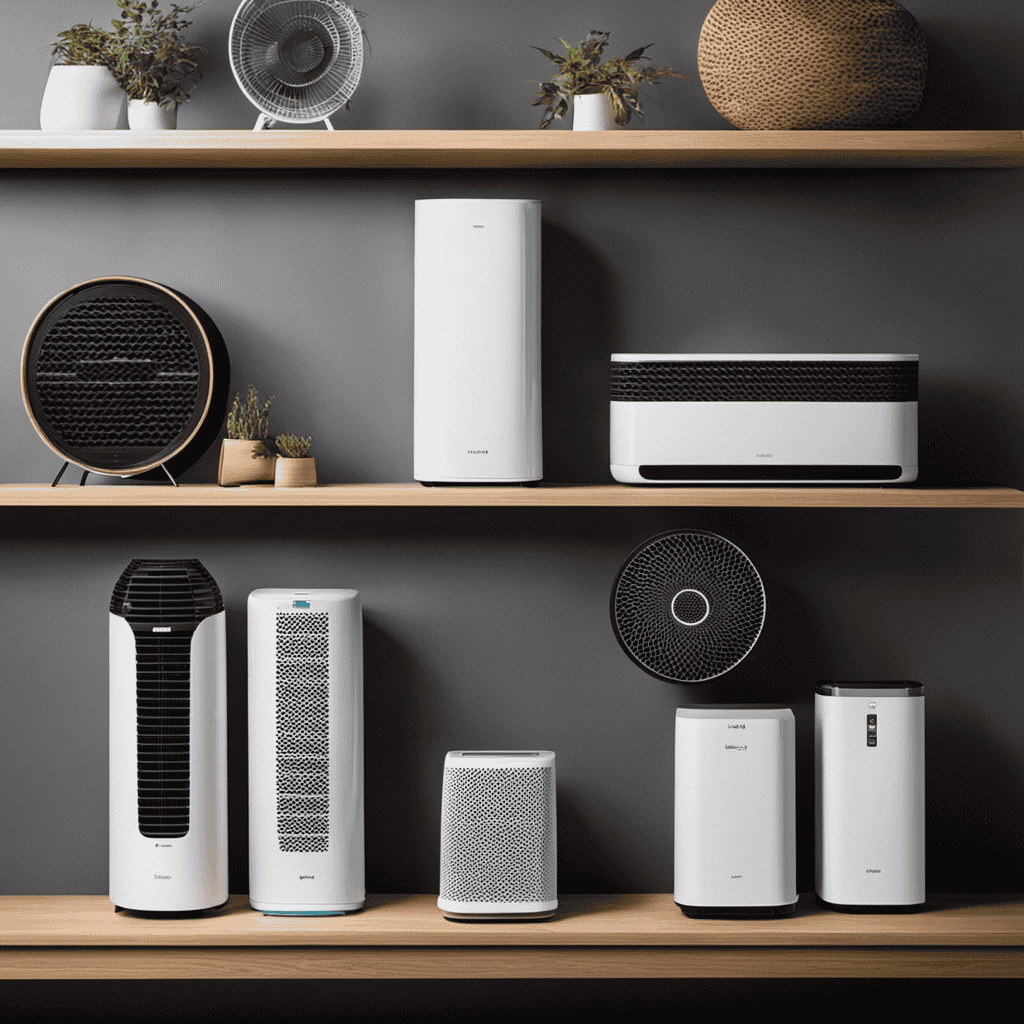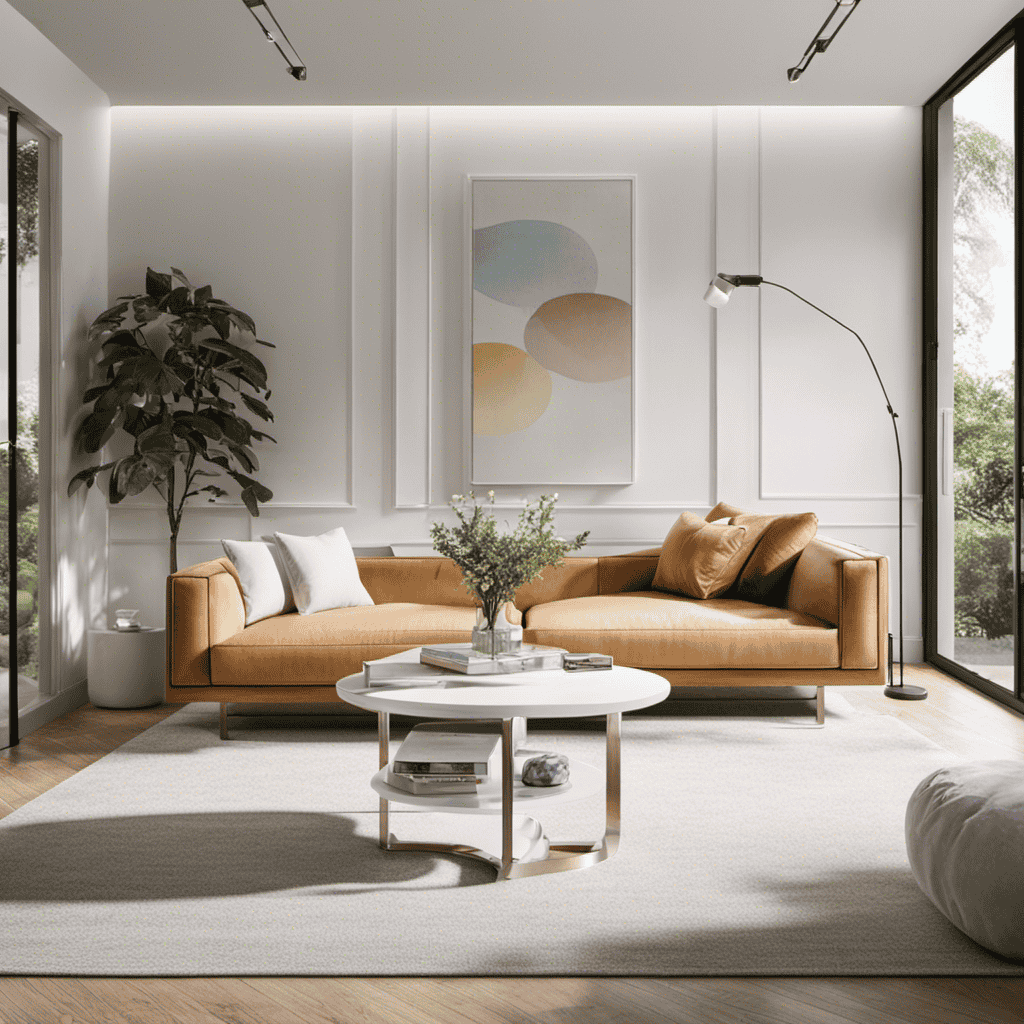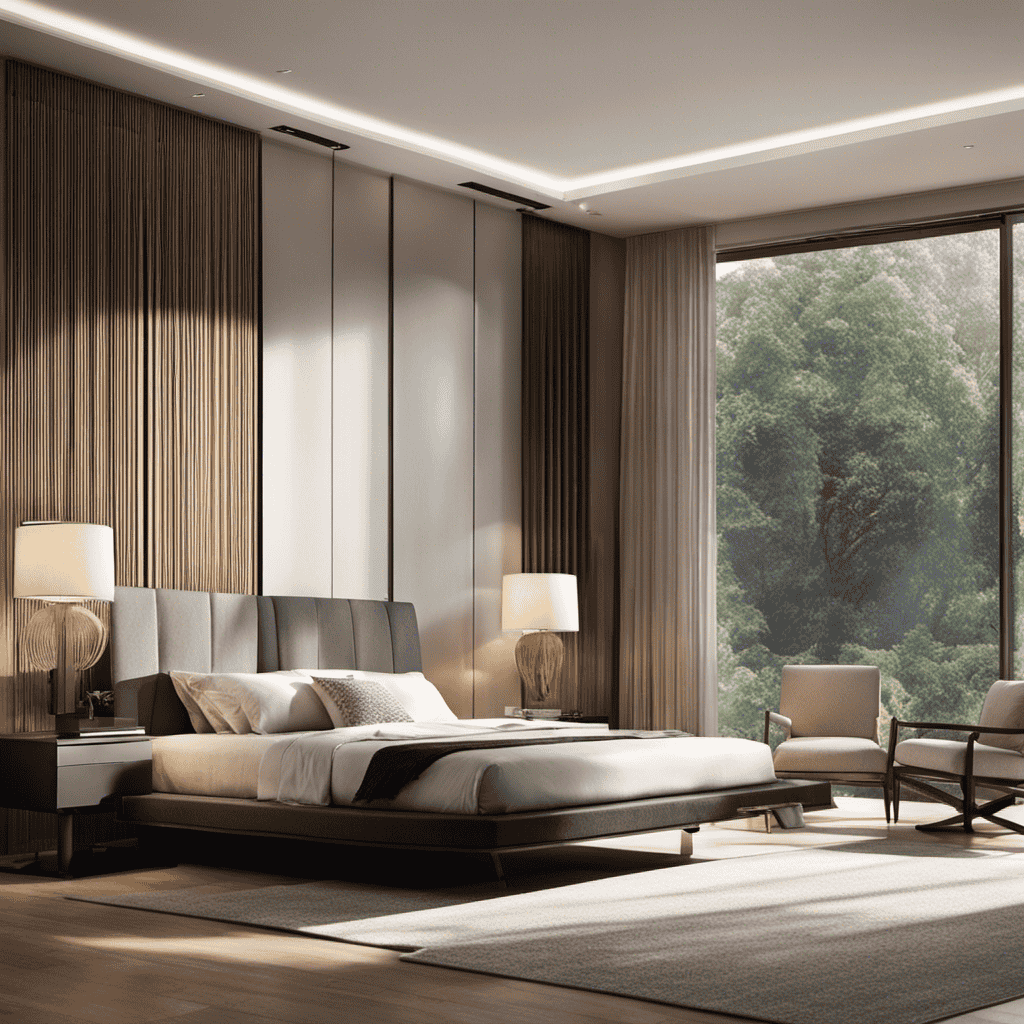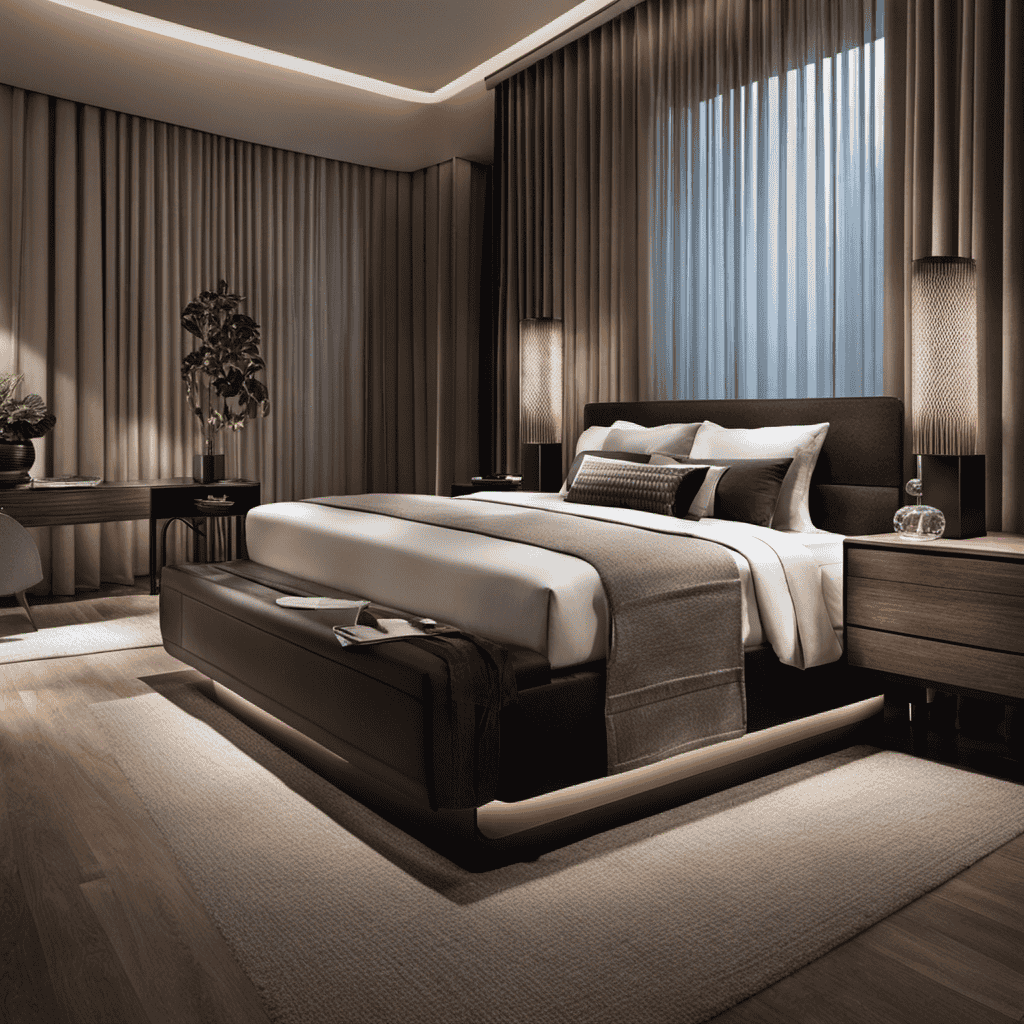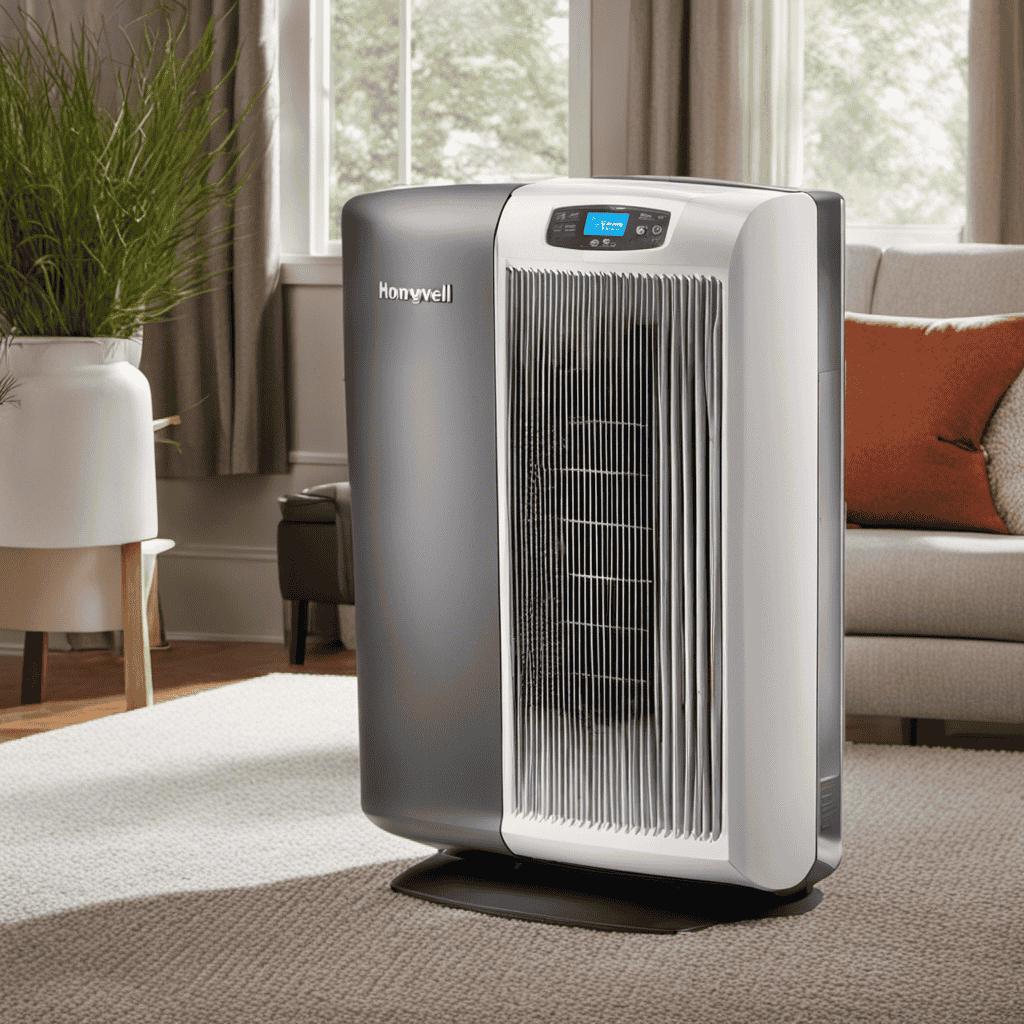I understand your concern – selecting an air purifier can feel daunting. With a plethora of choices available, how do you determine the best fit for your needs?
Well, fear not! In this article, I will guide you through the process of selecting the perfect air purifier. We’ll explore factors to consider, different types of purifiers, filter efficiency, noise levels, sizing considerations, ideal placement, customer reviews, and expert recommendations.
By the end, you’ll be equipped with the knowledge you need to confidently purchase an air purifier online.
Key Takeaways
- Factors to consider when choosing an air purifier include the size of the room, specific air quality needs, CADR, air purifier technologies, performance evaluation, coverage area, noise level, price, additional features, and specific needs and preferences.
- Understanding the different types of air purifiers is important, considering features and benefits, noise levels, filter efficiency, CADR and HEPA filters, and making an informed decision.
- Ideal placement for an air purifier involves placing it in a central location for optimal airflow and coverage, avoiding obstructions like walls or furniture, considering room size and the need for multiple purifiers, avoiding potential sources of pollution, and ensuring proper ventilation in the room.
- Evaluating air purifier filter efficiency includes understanding filter efficiency ratings, the technology behind air purifier filters such as HEPA, activated carbon, and UV-C filters, filter replacement, and using genuine replacement filters for optimal performance.
Factors to Consider When Choosing an Air Purifier
When choosing an air purifier, you’ll want to consider factors such as the size of the room and your specific air quality needs. Evaluating air purifier performance is crucial in ensuring that you invest in a device that effectively filters the air in your space.
To do this, you should look for metrics like Clean Air Delivery Rate (CADR), which measures the efficiency of the purifier in removing pollutants. Additionally, understanding air purifier technologies is essential in making an informed decision.
There are several types of technologies used in air purifiers, including High-Efficiency Particulate Air (HEPA) filters, activated carbon filters, and ultraviolet germicidal irradiation (UVGI). Each technology targets specific pollutants and has its own advantages.
By evaluating performance and understanding these technologies, you can select the air purifier that best suits your needs.
Now, let’s move on to understanding different types of air purifiers.
Understanding Different Types of Air Purifiers
To understand the different types of air purifiers, you should familiarize yourself with their features and benefits. When evaluating noise levels, it is important to consider the decibel rating of the air purifier. Some models have a quiet mode, which can be beneficial if you plan on using the purifier in your bedroom or office.
Additionally, comparing filter efficiency is crucial in determining the effectiveness of an air purifier. Look for purifiers that have a high CADR (Clean Air Delivery Rate) and HEPA (High-Efficiency Particulate Air) filters, as they are known to effectively capture airborne particles.
Understanding these features will help you make an informed decision when selecting an air purifier that suits your specific needs.
Now, let’s dive into evaluating air purifier filter efficiency.
Evaluating Air Purifier Filter Efficiency
Take a look at the filter efficiency ratings to determine how effectively it captures and removes airborne particles. When evaluating filter effectiveness, it’s important to understand the technology behind air purifier filters. Different types of filters have varying levels of efficiency in trapping pollutants. To help you visualize the differences, here is a table comparing four common types of air purifier filters:
| Filter Type | Efficiency Rating |
|---|---|
| HEPA | 99.97% |
| Activated Carbon | 80-90% |
| UV-C | 99% |
| Ionizer | Varies |
HEPA filters are the most efficient, capturing 99.97% of particles as small as 0.3 microns. Activated carbon filters are effective against odors and chemicals, with an efficiency of 80-90%. UV-C filters kill germs and viruses with a 99% efficiency rate. Ionizers vary in effectiveness depending on the model. Understanding these filter technologies will help you make an informed decision when choosing an air purifier. Now, let’s move on to another important factor to consider: the noise levels of air purifiers.
Noise Levels of Air Purifiers
When it comes to air purifiers, one important aspect to consider is the noise level they produce. Quietest air purifiers are highly sought after, especially for those who value a peaceful and undisturbed sleep environment.
However, it’s also crucial to strike a balance between noise reduction and air purification efficiency, as some models may sacrifice performance for silence.
In this discussion, we will delve into the impact of noise on sleep quality and explore the options available for finding a quiet air purifier that doesn’t compromise on air cleaning capabilities.
Quietest Air Purifiers
One option for finding a quiet air purifier is to look for models with noise-reducing features. These features can help minimize the noise produced by the purifier, making it more suitable for use in bedrooms or offices where silence is preferred.
When searching for the quietest air purifiers, it is also important to consider the specific needs of your household, especially if you have pets. Here are three key factors to consider:
-
HEPA filters: Look for air purifiers with high-quality HEPA filters, as these are effective in capturing pet dander and other allergens.
-
Multiple fan speeds: Choose a purifier with adjustable fan speeds, allowing you to customize the noise level based on your preferences.
-
Smart sensors: Opt for purifiers with smart sensors that can detect the air quality and adjust the fan speed accordingly, reducing the noise level when the air is clean.
Noise Impact on Sleep
The noise from an air purifier can have a significant impact on the quality of sleep. As someone who values a good night’s rest, I have done extensive research on the relationship between sleep quality and noise reduction.
Studies have shown that excessive noise during sleep can lead to fragmented sleep patterns and increased daytime sleepiness. This is particularly important for individuals who are light sleepers or have trouble falling asleep.
When choosing an air purifier, it is crucial to consider its noise levels. Look for models that are designed with noise reduction features, such as quiet operation modes or sound insulation technology. These features can help minimize the disruptive noise and promote a more peaceful sleep environment.
Prioritizing noise reduction when selecting an air purifier can greatly contribute to improving sleep quality.
Balancing Noise Reduction
Finding a model with noise reduction features is crucial for creating a peaceful sleep environment. When choosing an air purifier, it is important to consider the impact of noise on your ability to sleep soundly. Here are three key points to keep in mind:
-
Noise reduction technology: Look for air purifiers that are specifically designed to minimize noise levels. These models often include features like quiet mode settings or sound dampening materials to ensure a restful sleep.
-
Health benefits: Air purifiers not only help reduce air pollution, but they also have several health benefits. By removing pollutants like dust, pet dander, and allergens from the air, they can improve indoor air quality and reduce the risk of respiratory issues.
-
Consider your needs: Take into account your specific noise sensitivity and health concerns when selecting an air purifier. Different models offer varying levels of noise reduction and filtration capabilities, so it’s important to choose one that aligns with your requirements.
In conclusion, finding an air purifier with noise reduction features is essential for creating a peaceful sleep environment. It is important to consider the health benefits and your specific needs when making a selection.
Now, let’s move on to discuss sizing considerations for air purifiers.
Sizing Considerations for Air Purifiers
When it comes to choosing the right air purifier, one of the most important factors to consider is the size of the room where it will be used. Room size considerations play a crucial role in determining the effectiveness and efficiency of an air purifier.
A purifier that is too small for a room will not be able to effectively clean the air, while one that is too large may consume unnecessary energy. Therefore, understanding the square footage of your room and matching it with the appropriate air purifier size is essential for optimal performance.
Room Size Considerations
If you’re unsure about the size of the room, it’s best to measure it before purchasing an air purifier. Room size limitations play a crucial role in determining the effectiveness of an air purifier. Here are some key considerations to keep in mind:
-
Coverage area: Different air purifiers are designed to cover specific room sizes. It’s important to choose one that matches the square footage of your room to ensure optimal performance.
-
Air changes per hour (ACH): This refers to how many times the air purifier can clean the entire volume of air in a room in one hour. A higher ACH value is recommended for larger rooms to effectively capture and remove pollutants.
-
CADR rating: The Clean Air Delivery Rate indicates the purifier’s ability to remove specific airborne pollutants. Make sure the purifier’s CADR rating matches the size of your room for efficient air purification.
Considering these factors will help you select an air purifier that is suitable for your room size and maximizes its effectiveness.
Now, let’s delve into the energy efficiency of air purifiers.
Energy Efficiency of Air Purifiers
The energy efficiency of air purifiers can greatly impact their long-term cost effectiveness. When choosing an air purifier, it is important to consider its energy consumption and environmental impact. Energy-efficient models not only save on electricity bills but also reduce greenhouse gas emissions. To help you understand the energy efficiency of air purifiers, I have created the following table:
| Air Purifier Model | Energy Consumption (Watts) |
|---|---|
| Model A | 30 |
| Model B | 50 |
| Model C | 20 |
Analyzing the energy consumption of different models can help you make an informed decision. Transitioning into the next section about analyzing CADR ratings of air purifiers, it is important to consider both energy efficiency and performance when selecting the right air purifier for your needs.
Analyzing CADR Ratings of Air Purifiers
When it comes to choosing an air purifier, understanding CADR (Clean Air Delivery Rate) ratings is crucial. These ratings determine how efficiently an air purifier can remove pollutants from the air, ultimately impacting the overall air quality in your home or office.
To make an informed decision, it is essential to compare different models based on their CADR ratings and consider their potential impact on improving the air you breathe.
Understanding CADR Ratings
To understand CADR ratings, you should consider the air purifier’s effectiveness in removing specific pollutants from the air. CADR stands for Clean Air Delivery Rate, and it is a measure of how efficiently an air purifier can remove common pollutants such as dust, pollen, and smoke.
When evaluating CADR ratings, there are a few key factors to keep in mind:
-
Particle Size: Different air purifiers are designed to tackle specific particle sizes, so it’s important to choose one that targets the pollutants you are concerned about.
-
Room Size: CADR ratings are typically given for specific room sizes, so make sure the air purifier is suitable for the room you intend to use it in.
-
Air Changes Per Hour: A higher CADR rating means the air purifier can clean the air more quickly, resulting in more frequent air changes per hour.
Understanding CADR ratings is crucial when selecting an air purifier as it directly impacts its ability to improve indoor air quality.
Impact on Air Quality
If you want to improve the air quality in your home, consider the impact an air purifier can have.
Air pollution is a growing concern, and it can have detrimental effects on our health. A high-quality air purifier can help remove pollutants and allergens from the air, reducing the risk of respiratory issues and allergies.
Research has shown that using an air purifier can lead to significant health benefits, such as improved lung function and reduced symptoms of asthma and allergies.
The filters in air purifiers are designed to capture particles as small as 0.3 microns, including dust, pollen, pet dander, and even mold spores.
Comparing Different Models
Take a look at the features and specifications of various air purifier models to determine which one best suits your needs. When comparing different models, it’s important to consider the noise level and the impact on air quality.
Here are some factors to consider:
-
Noise Level:
-
Look for air purifiers with a low decibel rating to ensure a quiet operation.
-
Consider models with noise-reducing features such as soundproofing or fan speed control.
-
Read customer reviews to get an idea of how quiet the purifier actually is.
-
Impact on Air Quality:
-
Check the Clean Air Delivery Rate (CADR) to determine how effectively the purifier can remove pollutants.
-
Look for models with HEPA filters, which can capture particles as small as 0.3 microns.
-
Consider additional features like activated carbon filters for odor removal.
Assessing the Maintenance Requirements of Air Purifiers
Assessing the maintenance requirements of air purifiers can help you determine the level of upkeep needed for optimal performance. When it comes to noise reduction effectiveness, it is important to consider the type of air purifier you choose. Some models are designed to operate quietly, while others may produce more noise.
Additionally, it is crucial to factor in the air purifier maintenance costs. Different brands and models may have varying maintenance needs and associated costs. It is important to consider factors such as filter replacements, cleaning requirements, and any additional maintenance tasks required.
By understanding the maintenance requirements and associated costs, you can make an informed decision about which air purifier is right for you.
Now, let’s delve into comparing different brands of air purifiers.
Comparing Different Brands of Air Purifiers
When comparing different brands of air purifiers, it’s important to consider factors such as noise levels, maintenance requirements, and cost. Evaluating air purifier costs is crucial in finding the best value for your money. Some brands may offer similar features but have significantly different prices, so comparing prices across different models and brands is essential.
Additionally, comparing air purifier warranties is vital to ensure you are protected in case of any defects or malfunctions. Look for brands that offer longer warranties, as this indicates their confidence in the product’s quality and durability.
By evaluating costs and comparing warranties, you can make an informed decision and choose an air purifier that fits your budget while providing the performance and peace of mind you desire.
Now, let’s move on to budgeting for an air purifier.
Budgeting for an Air Purifier
To budget for an air purifier, you’ll need to consider factors such as your available funds, the size of the space you want to purify, and any additional expenses for filters or maintenance. It’s essential to assess your needs and prioritize features that are most important to you. Noise reduction benefits might be a crucial factor to consider, especially if you plan to use the air purifier in your bedroom or office. There are various air purifier options available on the market, each with its own set of features and price points. To help you make an informed decision, here is a comparison table showcasing three popular air purifiers:
| Air Purifier | Coverage Area | Noise Level | Price |
|---|---|---|---|
| Brand A | 400 sq. ft. | 30 dB | $199 |
| Brand B | 600 sq. ft. | 25 dB | $249 |
| Brand C | 800 sq. ft. | 35 dB | $299 |
Considering these factors will ensure you find an air purifier that fits your budget and meets your specific needs.
Considering Additional Features of Air Purifiers
If you’re looking for an air purifier with extra features, such as a built-in timer or remote control, there are several options available on the market. These additional features can enhance the functionality and convenience of your air purifier.
Here are three sub-lists to consider when selecting an air purifier with additional features:
-
Smart Sensors: Some air purifiers come with smart sensors that monitor the air quality in real-time. These sensors can detect pollutants and automatically adjust the fan speed to maintain clean air.
-
Filter Replacement Indicator: A filter replacement indicator is a useful feature that notifies you when it’s time to change the filters. This ensures that your air purifier is always operating at its optimal performance.
-
Multiple Fan Speeds: Having multiple fan speeds allows you to customize the airflow according to your preferences. It can provide flexibility in adjusting the purifying power based on the air quality and noise level desired.
Considering these additional features can help you make an informed decision when choosing an air purifier.
Now, let’s explore the next important factor in determining the ideal placement for an air purifier.
Determining the Ideal Placement for an Air Purifier
Finding the perfect location for your air purifier is crucial in order to maximize its effectiveness in purifying the air. When it comes to placement considerations, there are a few key factors to keep in mind.
First, it’s important to place the air purifier in a central location within the room to ensure optimal airflow and coverage. Placing it near a wall or furniture can obstruct the air circulation, reducing its efficiency.
Additionally, consider the size of the room. Larger rooms may require multiple air purifiers for maximum effectiveness.
It’s also important to avoid placing the purifier near potential sources of pollution, such as smoking areas or pet beds.
Researching Customer Reviews and Ratings of Air Purifiers
When it comes to researching customer reviews and ratings of air purifiers, there are a few key points to consider.
Firstly, it is important to find trustworthy review sources that provide unbiased and reliable information.
Secondly, verified customer experiences can offer valuable insights into the performance and effectiveness of different air purifier models.
Lastly, the impact of these reviews and ratings on purchasing decisions cannot be underestimated, as they play a significant role in helping consumers make informed choices.
Trustworthy Review Sources
You’ll want to look for trustworthy review sources to ensure you’re getting accurate information about air purifiers. When researching air purifiers, it’s important to rely on credible sources that provide unbiased and comprehensive reviews. Here are three reasons why trustworthy sources are essential:
-
Expert Reviews: Reputable websites, such as Consumer Reports or Wirecutter, employ experts who thoroughly test and evaluate air purifiers. Their expertise ensures that the information you receive is reliable and based on rigorous testing.
-
Verified Purchase Reviews: Customer experiences are valuable when choosing an air purifier. Look for review sources that verify purchases to ensure that the feedback comes from genuine customers who have actually used the product.
-
Aggregated Reviews: Websites that aggregate reviews from multiple sources can provide you with a broader perspective and a more comprehensive understanding of the pros and cons of different air purifiers.
Verified Customer Experiences
In my quest to choose the best air purifier, I have diligently researched various trustworthy review sources. However, I have come to realize that while reviews provide valuable insights, they may not always reflect the actual customer experience. This led me to consider the importance of verified customer experiences in making an informed decision.
By examining customer satisfaction and effectiveness comparisons, I can gain a deeper understanding of how well an air purifier performs in real-world scenarios. Verified customer experiences provide valuable firsthand accounts of the product’s performance, highlighting its strengths and weaknesses.
Analyzing these experiences allows me to evaluate the air purifier’s ability to effectively remove pollutants, reduce allergens, and improve indoor air quality. It also helps me gauge the durability, noise levels, and overall satisfaction expressed by customers.
Transitioning into the next section about the impact on purchasing decisions, these verified customer experiences play a crucial role in guiding my final choice.
Impact on Purchasing Decisions
Considering the impact of verified customer experiences, you can make a more informed purchasing decision based on real-world feedback. When it comes to purchasing challenges, such as choosing an air purifier, it’s crucial to understand consumer preferences. Here are three key points to consider:
-
Diverse Needs: Consumers have different requirements, whether it’s for allergies, pet dander, or general air quality. Verified customer experiences can help you find a purifier that specifically addresses your needs.
-
Reliability: Reviews from verified customers provide insights into the reliability of air purifiers. By analyzing common issues reported by customers, you can make a more informed decision and avoid potential pitfalls.
-
Performance: Through verified customer experiences, you can gather information about how well an air purifier performs in real-world scenarios. This feedback allows you to compare different models and choose the one that delivers the desired results.
Consulting With Allergy and Asthma Experts for Air Purifier Recommendations
First, talk to allergy and asthma experts to get their recommendations for the best air purifiers.
When it comes to choosing an air purifier, it’s crucial to consult with professionals who specialize in allergies and asthma. These experts have extensive knowledge and experience in identifying the most effective air purifiers for individuals with respiratory conditions. They can provide cost-effective recommendations that not only improve indoor air quality but also offer long-term health benefits.
Tips for Purchasing an Air Purifier Online
When purchasing an air purifier online, it’s important to read customer reviews to ensure you’re making an informed decision. Customer testimonials provide valuable insights into the effectiveness of air purifiers and can help you determine if a particular model will meet your needs.
Here are three key factors to consider when evaluating customer reviews:
-
Air Purifier Performance: Look for reviews that discuss how well the purifier removes pollutants, such as allergens, dust, and smoke. Pay attention to whether customers report noticeable improvements in air quality and reduced allergy or asthma symptoms.
-
Noise Levels: Some air purifiers can be noisy, especially at higher fan speeds. Check for reviews that mention the noise level and whether it is disruptive or tolerable.
-
Longevity and Maintenance: Assess reviews that mention the durability and lifespan of the purifier, as well as the ease of filter replacement and overall maintenance.
Frequently Asked Questions
Can Air Purifiers Eliminate All Types of Allergens?
Yes, air purifiers can effectively eliminate common allergens like dust, pollen, and pet dander. However, their effectiveness may vary depending on the specific model and the size of the particles they are designed to filter.
How Long Do Air Purifier Filters Typically Last?
Filters can last for months, depending on usage and air quality. It’s important to follow the manufacturer’s replacement schedule to ensure optimal performance. Regular maintenance and cleaning can also extend their longevity.
Are There Any Health Risks Associated With Using an Air Purifier?
There are some health risks associated with using an air purifier, but the benefits and effectiveness measures outweigh them. It’s important to choose a purifier that suits your needs and consider factors like filter type and room size.
Can Air Purifiers Remove Odors From the Air?
Air purifiers are effective at removing odors from the air. They utilize various odor removal techniques, such as activated carbon filters, to target different odor sources. Choosing the right air purifier is essential for optimal odor elimination.
Are There Any Government Regulations or Certifications for Air Purifiers?
Yes, there are government regulations and certifications for air purifiers. These standards ensure that air purifiers meet certain criteria and undergo testing procedures to ensure their efficacy and safety.
Is Building an Air Purifier as Effective as Buying One?
When it comes to air purifiers, building your own might seem like a cost-effective option. However, professionals emphasize that following air purifier building tips might not be as effective as buying a professionally made unit. It’s important to consider the potential limitations and safety concerns of DIY air purifiers.
Conclusion
After conducting extensive research and analysis, it’s safe to say that choosing the perfect air purifier has become somewhat of an art form. With a plethora of factors to consider, from filter efficiency to noise levels, it can feel like navigating a labyrinth.
However, fear not! Armed with the wisdom of customer reviews and the guidance of allergy and asthma experts, the ideal air purifier is within reach.
So go forth, my fellow air purifier enthusiasts, and conquer the online marketplace with confidence!
